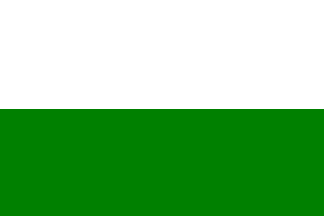
image by Dov Gutterman, 21 July 2002

Last modified: 2006-03-04 by dov gutterman
Keywords: colombia | universities |
Links: FOTW homepage |
search |
disclaimer and copyright |
write us |
mirrors
See Also:

image by Dov Gutterman, 21 July 2002
Image based on <www.udea.edu.co>.
Dov Gutterman, 21 July 2002
The flag of the Department of Antioquia
is derived from the flag of the University of Antioquia.
Carlos Thompson, 23 March 2003
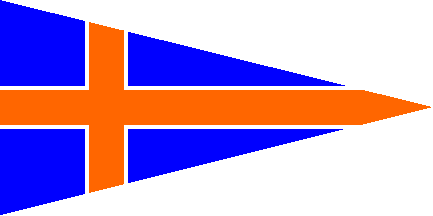
image by Ivan Sache, 14 August 2002
Located in Barranquilla, Atlantico Department. The flag shown on
the website is a blue triangular flag with an orange Scandinavian
cross separated from the blue background by a thin white
fimbriation. Exact proportions cannot be infered from the
original source. I have used overall 1:2 proportion by default.
Source: <www.uniatlantico.edu.co>.
Ivan Sache, 14 August 2002
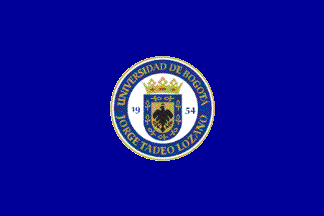
Current flag of the University
image by Ivan Sache, 3 December 2005
.gif)
Current emblem of the University
image from the University
website
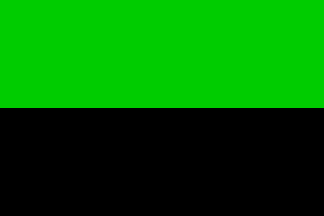
Former, original flag of the University
image by Ivan Sache, 3 December 2005
The Jorge Tadeo Lozano University of Bogotá
(Universidad de Bogotá Jorge Tadeo Lozano) was founded on 5
February 1954 by Joaquín Molano Campuzano, Javier Pulgar Vidal
and Jaime Forero Valdés. The main goal of the University was
"to continue on the cultural and scientific work initiated
during the Botanical Expedition in the Kingdom of New
Granada." This expedition (Expedición Botánica
del Nuevo Reino de Granada) took place in 1783.
Accordingly, the University is named after Jorge Tadeo Lozano
(1770-1816). Lozano, born in a noble family from Santafé de
Bogotá (today internationally known as Bogotá), studied
chemistry in the Royal Laboratory of Madrid (Spain) and was
appointed Professor of Chemistry in the Colegio de Nuestra
Señora del Rosario in Santa Fé. Lozano took part to the
Botanical Expedition as a zoologist. In 1801, he was visited in
Santafé by the famous naturalists Humboldt and Bonpland. Lozano
was also a patriot. He wrote in 1811 a proposal of liberal
Constitution and set up an alliance with Venezuela, which is
considered as the first attempt of pan-Americanism. In 1814,
Lozano published with José Ángel Manrique the struggle
newspaper "El anteojo de larga vista"; he was elected
Representative of the Province of Chocó at the General Congress
gathered in Santafé. Lozano was arrested and sentenced to death
in 1816 with other patriots; he was shot on 6 July 1816. One of
the founders of the University, Joaquín Molano, is a descendant
of Joaquín Gómez Hoyos, husband of María Tadea Lozano e Isasi,
Lozano's widow.
The first faculties of the University, which is nicknamed
"la Tadeo", opened in 1955. The University increased
with time and more faculties were incorporated. In 1962, the
Faculty of Marine Sciences initiated teaching of Aquaculture and
Oceanography in Colombia. The bicentenary of the Botanical
Expedition was celebrated in 1983 with the structuration of the
University into three academic areas recalling the goals of
the Expedition: Engineering and Natural Resources
(Agricultural Management, Marine Biology, Food Science, Agrology
and Geography), Law and Economics (Law, Management, Information
Systems, International Trade, Public Accounting, Economics,
Market, International Relations, Foreign Trade and Tourism) and
Arts, Design and Communication (Architecture, Interior Design,
Fine Arts, Social Communication, Graphic Design, Industrial and
Commercial Design). Some faculties have been relocated in
Cartagena and Santa Marta.
The flag of the University is blue with the emblem of the
University in the middle. This flag was adopted by the Board of
the University on 1 December 2001 (Decree #19). It superseded the
former, original flag of the University, which was horizontally
divided green-black.
The University used three successive emblems. The first, original
emblem shows a green star with the white letters UJTL, the
acronym of the University, supported by a stylized bird (?). This
emblem is based on the emblem of the Peruvian party APRA, itself based on the Halcón from
the local culture Chavin from Huantar. It recalls the strong
Indo-American feelings of APRA, shared by the founders of the
University.
The second emblem of the University was proposed by Dr. Fabio
Lozano y Lozano, President of the Board of the University and
member of the International Institute of Genealogy and Heraldry,
and approved by the Board on 13 June 1960. The shield is:
"El de Bogotá, teniendo en cuenta el nombre de la misma y
el hecho de haber sido fundada en esta ciudad". (The
[shield] of Bogotá, because of bearing the name of the city and
having been founded in the city). The graphical design of the
emblem was made by the artist César Pedraza, alumnus of the
Faculty of Geography of the University. The shield of the
University differs from the standard coat
of arms of Bogotá by its Spanishized shape and some further
details. The original shield of Santafé de Bogotá was granted
by Emperor Charles V for the whole Kingdom of New Granada, by
patented letters signed on 3 December 1548 in Valladolid:
"… por sus armas conocidad un escudo que en medio dél
haya una águila negra rampante entera, coronada de oro, que en
cada mano tenga una granada colorada en campo de oro, y por erla
unos ramos con granadas de oro en campo azul …". The
eagle (águila) symbolizes greatness and noble view; as portrayed
on the shield, it is an adaptation of Isobel the Catholic's
eagle. The shield is crowned by a Duke's coronet, as it is often
the case on the shield of Spanish cities.
The third, currently in use, emblem of the University was
proposed by Dr. Alfonso Velasco Rojas, Head of the Department of
Publishing and Corporate Emblematic of the University and
approved by the Board on 1 August 2000 (Decree #13). The
graphical design of the emblem was made by Felipe Duque Rueda.
The shield of the University is surrounded by a ring bearing the
name of the University and flanked by the year of foundation: 19
(left) 54 (right). The whole emblem is coloured in blue; the name
of the University is written below the emblem in black. The
representation of the shield has been improved compared with the
second version of the emblem of the University. The multicoloured
version of the emblem shall be used only in the official
documents of the University released by the Rectorate and the
General Secretariat. The flag of the University features that
coloured version of the emblem.
Source: Universidad
de Bogota Jorge Tadeo Lozano, located by Valentin Poposki.
Ivan Sache, 3 December 2005
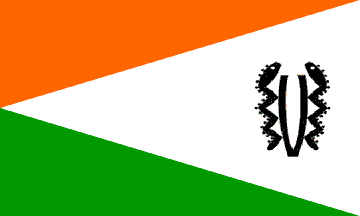
image by Carlos Thompson, 28 May 2003
Translated from Universidad del Bosque (Bogota)
website at <www.unbosque.edu.co>:
"Using several schemas used for sumarizing a few of the
program ideas, the flag was designed. A rectangle which two
oblique lines divide in three triangles: the upper and the lower
are rectangle (triangles) and in the middle another triangles
that is openning till it reache the bass and continues to the
infinity meaning the raising complexity of our studies, the
progressive increment of our knowledge that never ends. The
upper in orange color, the color of medicine, the lower in green
color symbol of hope, and the central white, sign of clean and
purity and in it the symbol".
Carlos Thompson, 28 May 2003

image by Carlos Thompson, 22 March 2003
Acording to the site of the Universidad del Cauca <www.unicauca.edu.co>,
the flag has 12 stripes.
From the site: "Formada por doce barras azules y rojas de
igual tamaño, alternadas y colocadas perpendicularmente al asta,
fue adoptada en la misma fecha y por el mismo Acuerdo de Alta
Corporación Universitaria, con ocasión de conmemorarse un año
más de su fundación del Alma Mater." [Formed by twelve
equalsized stripes alterned blue and red, perpendicular to the
hoist, was adopted the same date (November 7, 1922) and by the
same Agreement of High University Corporation (Consejo Directivo
Universitario) in conmemoration of one more year of the fundation
of the Alma Mater.]
Carlos Thompson, 22 March 2003
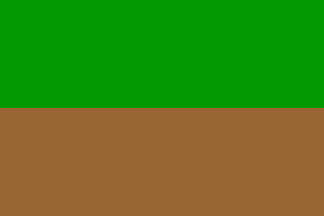
image by Carlos Thompson, 23 March 2003
Image based on <www.unicordoba.edu.co>.
Dov Gutterman, 21 July 2002
In the site they say that the flag is green and brown.
Carlos Thompson, 23 March 2003
.jpg)
Coat of Arms
image from <www.unicundi.edu.co>
At <www.unicundi.edu.co>
there is the official Coat of Arms of the Universidad de
Cundinamarca (Cundinamarca University) and an
isotype. I think that the flag of the UDEC (acronym of
the University) is the same flag as the Cundinamarca
Department, but with the UDEC Coat of Arms in the center.
Jairo Alonso Méndez Méndez, 7 October 2005

image by Carlos Thompson, 17 March 2003
Universidad de La Salle, Bogota,
Colombia (University of La Salle) - According to <www.lasalle.edu.co>,
the picture show a blue-white-blue, equally divided vertically
flag, but in the text they say that the white is wider and the
coat of arms is in the middle enclosed by a golden circle.
Carlos Thompson, 17 March 2003
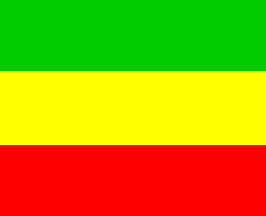
image by Ivan Sache, 9 June 2001
Universidad de Nariño - 22:27 flag, horizontally divided
green-yellow-red. Flag shown on <www.udenar.edu.co>,
located by Dov Gutterman, with proportion 2:3. Anyway,
the text near the image clearly states that the proportion shall
be 22:27, the usual size being 1.10 x 1.35 m and the flag being
hoisted on a pole of 2.50 m high. The shield of the University
shall be placed in its middle (I don't understand of what, the
pole, or, most probably, the flag itself).
Ivan Sache, 9 June 2001
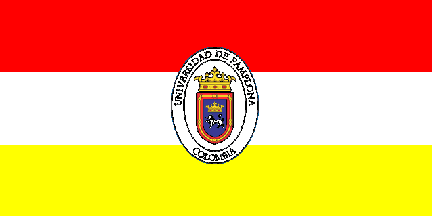
image by Dov Gutterman, 21 July 2002
Image based on <www.unipamplona.edu.co>.
Dov Gutterman, 21 July 2002
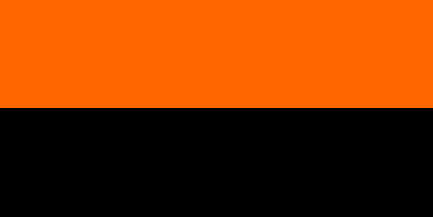
image by Ivan Sache, 3 June 2001
Flag of Universidad de San Buenaventura Cali is based on <www.usb.edu.co>.
Dov Gutterman, 3 June 2001
The flag is horizontally divided orange-black. Proportion
seems to be 1:2 on the image of the website. The website says
that orange stands for youth, creativeness and intelligence, and
black for sobriety, rigour and academic excellence.
Ivan Sache, 3 June 2001
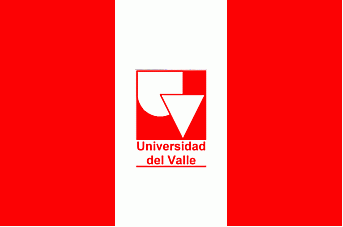
image from <www.univalle.edu.co>,
located by Carlos Thompson, 27 May 2003
Translation from Universidad del Valle (Cali, Valle del Cauca)
website <www.univalle.edu.co>:
"The Valle University adopts a flag design possing as a
basic feature a great symbolic force, giving red as a
representative color. The flag design shows three equalsized
vertical bars, in order: red, white, red; representing the three
basic activities of the University: Teaching, Research and
Extension. In the central white bar the Logo is placed in
red. The flag must be used in every important events for the
University as one of its representative symbols".
Carlos Thompson, 27 May 2003
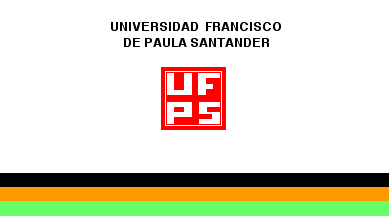
image by Ivan Sache, 9 June 2001
Universidad Francisco de Paula Santander - 5:9 (apparently)
flag, horizontally divided white-black-orange-light green
(12:1:1:1). The name of the University, in black, is placed in
the white stripe, above the logo of the University.
Flag shown on <motilon.ufps.edu.co>,
located by Dov Gutterman, which says (in Spanish):
'There is obviously an historical gap: we don't know according to
which process the flag which currently flies in the Benefactors'
Park was adopted as the official flag of the University.'
Ivan Sache, 9 June 2001
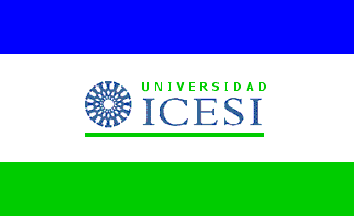
image by Ivan Sache, 25 December 2002
ICESI was founded in 1979 by a group of business leaders from
the Department of Valle. It is located
in the area of Pance, a suburb in the south of Cali. The flag is
horizontally divided blue-white-green (1:2:1) with the emblem of
the University placed in the midle of the white stripe. The
official size of the flag is 1.10 x 1.80 m (approx. 3.5 x 5.8
ft). The emblem of ICESI is made of a blue rosette with letters L
placed concentrically around the circumference, UNIVERSIDAD in
green capital letters and ICESI in blue capital letters, both
being placed right to the rosette, and a green line under all
items, which symbolizes unity.
Source: <homero.icesi.edu.co>,
located by Dov Gutterman
Ivan Sache, 25 December 2002
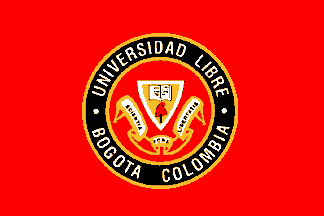
image by Dov Gutterman, 21 July 2002
Image based on <www.ulibrepei.edu.co>.
Dov Gutterman, 21 July 2002
According to the picture at <www.ulibrepei.edu.co>,
the seal seems smaller and towards the hoist. The
description says however that the seal is in the center.
Carlos Thompson, 17 March 2003
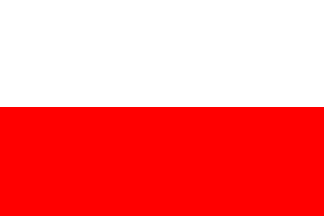
image by Ivan Sache, 9 June 2001
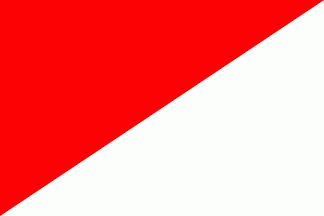
image by Carlos Thompson, 24 June 2003
Universidad Manuela Beltran (Bogotá)
- 2:3 (by default) flag, horizontally divided white-red. Flag
shown on <www.umb.edu.co>,
located by Dov Gutterman.
Symbolics:
- White stands for peace, science and academic harmony.
- Red stands for effort and solitary work.
Ivan Sache, 9 June 2001
In the website of the university reported above they only say
that the colors of the flag are white and red and some drawing
that is not a flag is shown, suggesting a horizontal divided
flag. In <www.umb.edu.co>
, there is a picture of the flag and a link to an animated
version. This annimate version is horizontal white over
red, with the emblem. The photograph is from a stand flag
but it seems to be diagonal divided, white on the top-hoist and
red on the fly-bottom, and includes the emblem (set diagonally so
at it looks right in the stand flag).
The flag I have seen flying is diagonally divided, with no
emblem. Let me confiirm, I am pretty sure it is diagonally
divided but last time I checked there was no wind (and I was
driving) so I am not sure on the disposition of the colors.
Red seemed to be above, and white seemed to be towards the fly,
anyhow.
Carlos Thompson, 24 June 2003

image by Ivan Sache, 3 June 2001
Flag of UPB is based on <www.upb.edu.co>.
Dov Gutterman, 3 June 2001
This University is Colombian. UPB stands for: Universidad
Pontificia Bolivariana. The flag of UPB is horizontally divided
red-green. 2:3 proportion used by default. The website says that
red stands for charity, and black for science and modesty.
Ivan Sache, 3 June 2001
UPB located in the famous city of Medellin,
Colombia. At <www.upb.edu.co>,
you'll find the Coat of Arms in which you find prominently the
Cross of Christ (called by them "Cruz de los Caballeros de
Portugal", that is, "Cross of the Knights of
Portugal").
Jorge Candeias, 3 June 2001
Faculty of Law and Political Sciences
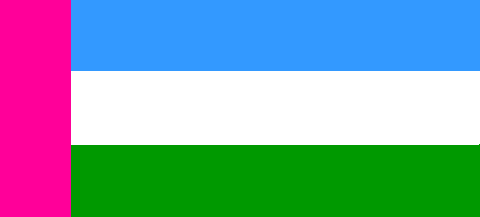
image by Ivan Sache, 25 December 2002
Faculty of Law and Political Sciences, University Santiago of Cali - The image of the flag, shown
without comments on the aforementioned website, is a bit
problematic. The flag is made of three horizontal stripes,
blue-white-green, and a vertical pink stripe is placed along the
hoist. The overall proportion of the image is 100:222, but
excluding the vertical stripe, we have a 1:2 flag! The colours
seem also to be weird, especially the pink, but they are derived
from the University shield, which is shown with a blue field, a
green border and pink writings.
Source: <www.usaca.edu.co/derecho>,
located by Dov Gutterman.
Ivan Sache, 25 December 2002
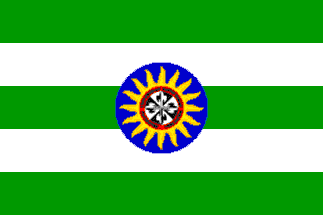
Note: this image is incomplete - see below.
image by Carlos Thompson, 28 May 2003
Translated from Universidad Santo Tomás websites: <www.usta.edu.co>
(Bogotá) and <www.ustabuca.edu.co>
(Bucaramanga, Santander):
"The flag is composed by five horizontal bands, three in
green and two white alternated, the university shield in the
middle and in the top the national tricolor in triangle".
The pictures do not show the flag completly , so I know I miss
the "national tricolor in triangle", this should mean a
triangle of yellow, blue and red.
Carlos Thompson, 28 May 2003
Here are links to other Education Institutes flags:
- Centro
Piloto Simón Bolívar
- Colegio Bolívar
- Colegio CIEDI
- Colegio
Cooperativo Técnico Comercial "Sagrado Corazon de
Jesus"
- Colegio
de Bachillerato - Universidad Llibre
- Colegio
el Triángulo
- Colegio
Filipense "Nuestra Señora de la Esperanza"
- Colegio
Montemore
- Colegio
Nuestra Señora del Rosario de Funza
- Colegio
Universidad Catolica de Manizales Nuestra Senora de la
Presentacion
- Colegio
San Felipe Neri
- Colegio
Santa María Stella Maris
- Escuela
de Ingeniería de Antioquia
- Escuela
Normal Superior Santa Teresita
- Gimnasio del
Norte
- Gimnasio
de Los Cerros
- Instituto
Champagnat
- Instituto
Teclonogico de Soledad Atlantico - ITSA
- Liceo
Montería
- Liceo
Sahagún Cooperativo Mixto
- UNITEC
- Universidad
Autonoma de Caribe
- Universidad
Autónoma de Manizales
- Universidad
de Medellin
- Universidad
INCCA de Colombia
- Universidad
Tecnologica de Bolivar
Dov Gutterman and Valentin Poposki